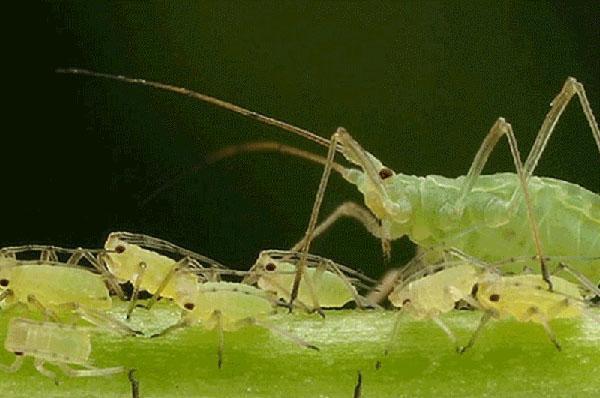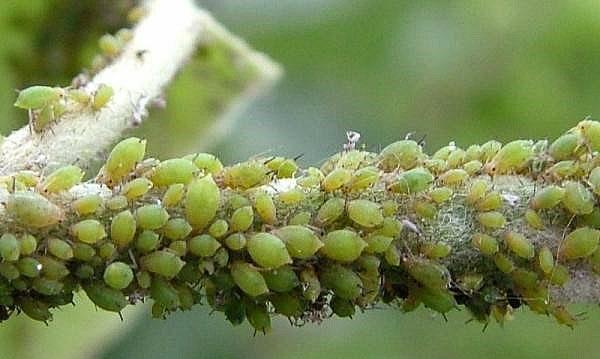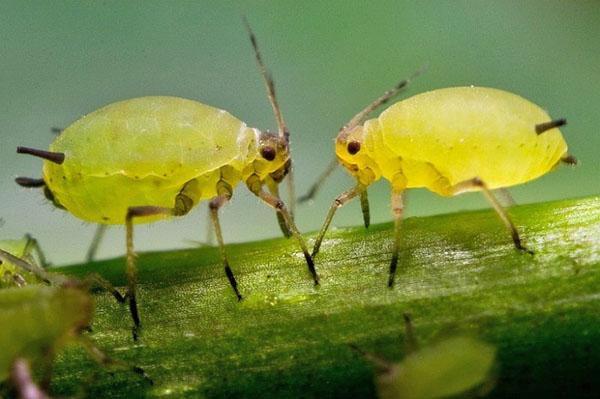Aphids rage on a pear - how to treat it?
 Among the thousands of species of aphids in the world, several species have chosen the pear, causing significant damage to the tree. Aphids on a pear - how to process? Is a frequently asked question. But it is necessary: how and when to process the pear so that there are aphids on it. To do this, you need to know the pest "by sight", the stages of development and reproduction. It is impossible to defeat the universal evil, but man has learned to keep the numbers within the limits of the least harm.
Among the thousands of species of aphids in the world, several species have chosen the pear, causing significant damage to the tree. Aphids on a pear - how to process? Is a frequently asked question. But it is necessary: how and when to process the pear so that there are aphids on it. To do this, you need to know the pest "by sight", the stages of development and reproduction. It is impossible to defeat the universal evil, but man has learned to keep the numbers within the limits of the least harm.
What is terrible for aphids

The aphid is a cephalopod insect no larger than 3 mm in size. It can be green, brown, black, red. In development, they pass the pupa stage. The first individual will emerge from an egg left in the fall in the trunks of the trunk or on the ground in the near-trunk circle.
The first aphids start reproduction, giving offspring 16 times over the summer. The colony is growing exponentially, uncontrollably. Each next individual lays 60 eggs. The tops of the shoots stop growing, the leaves curl into a tube, creating a refuge for the colony. Check out what aphids look like on a pear in the photo:
In the second half of summer, flying females of the Pear aphid appear. They must fly to another tree and reproduce there. At the end of summer, male aphids will appear in the clutch, which have wings and are not in the colony. In the fall, they will fertilize females, they will lay eggs for procreation next year.
Pear aphids not only change the composition of the cell sap, causing the leaf blade to reshape. This sac, filled with cell sap, secretes sweet feces. Ants feed on sweet honeydew; a sooty mushroom grows on it. The tree is inhibited, photosynthesis is disturbed. But suckers also fly. And they can transmit the virus from an infected tree to a healthy one through saliva. How to process aphids on a pear depends on the degree of settlement and period.
The presence of a large number of ants on the site will inevitably lead to the dispersal of aphids. Therefore, the fight for the cleanliness of the garden should be comprehensive and systematic.
Varieties of aphids
 Among the many species of aphids, 20 species live on pears. They like the taste of pear juice.
Among the many species of aphids, 20 species live on pears. They like the taste of pear juice.
Green aphids live not only on the pear, but also on other hearth trees. It is she who, from the very spring, inhabits the delicate foliage from the back. Leaves curl, the shoot stops developing.
Folk remedies are effective in the initial period. As soon as the leaf is curled up into a tube, neither dust nor a drop of moisture penetrates into it. The upper insects will be destroyed, but the colony will recover again.
Brown aphid is a pear pest. The egg is black, shiny, attached to the bark of a tree. The length of an adult insect is 2.5 mm. The color is deep black. Swelling from the juice, the aphid takes on a brown hue. The insect pierces the leaves along the central vein of the leaf. There are bulges for the larvae. Leaves lose their shape and color. The tree takes on an autumn color
Blood aphids are inhabitants of a mild climate. Populates apple trees, pear. The peculiarity of this aphid is that when crushed, the liquid is red, and the colony resembles a cotton ball. Each individual is covered with white fluff.
 Blood aphids feed on shoots, trunks, roots. The place where the wound from the sucker appeared does not heal, an ulcer appears - a direct gateway to fungal diseases. Young saplings, which it destroys, are more exposed to the invasion of bloody aphids. The laid eggs overwinter in the roots. Adult aphids remain there. Generations over a season of 10, each female gives rise to 200 individuals. In summer, winged females expand their habitat.
Blood aphids feed on shoots, trunks, roots. The place where the wound from the sucker appeared does not heal, an ulcer appears - a direct gateway to fungal diseases. Young saplings, which it destroys, are more exposed to the invasion of bloody aphids. The laid eggs overwinter in the roots. Adult aphids remain there. Generations over a season of 10, each female gives rise to 200 individuals. In summer, winged females expand their habitat.
So how to treat aphids on a pear to free the tree from adversity?
Methods for the prevention and control of aphids
 During the season, the gardener constantly inspects the garden, which is food for many insects. Carrying out preventive measures can postpone the appearance of aphids, reduce the number, but it is impossible to completely rid the garden of it. Before you fight aphids on a pear, you can prevent its appearance.
During the season, the gardener constantly inspects the garden, which is food for many insects. Carrying out preventive measures can postpone the appearance of aphids, reduce the number, but it is impossible to completely rid the garden of it. Before you fight aphids on a pear, you can prevent its appearance.
- The eggs on the bark of the tree are destroyed in late autumn. The bark is cleaned of dirt, cracks are treated with an antiseptic, and covered with pitch. After the tree is whitewashed. The trunk circle is dug up.
- In autumn, the bark of the tree and the trunk circle are poured with very hot water, up to 80 degrees. The action is short-lived. The bark will survive, the insect eggs will die.
- In spring, the tree is protected from aphids crawling out of the ground and their carriers, ants, by placing on the tree trunk sticky belt.
- Even before bud break, insecticide treatment is carried out for aphids. Most of the first larvae will die.
Treatments with chemicals against aphids can only be carried out before fruit setting and after harvest.
 An effective method of chemical preventive treatment is considered to be treatment in early spring before swelling of the buds with Kinmix, before flowering with Agravertin, after the ovary of fruits - with Iskra. In the future, chemicals are used in exceptional cases.
An effective method of chemical preventive treatment is considered to be treatment in early spring before swelling of the buds with Kinmix, before flowering with Agravertin, after the ovary of fruits - with Iskra. In the future, chemicals are used in exceptional cases.
Using folk remedies to treat aphids on a pear is better? Insects, natural enemies of aphids - ladybugs, hoverflies, lacewings, aphelinuses - remain. Under favorable conditions, they can significantly thin out the pest colony.
Besides, aphid washed off with a stream of cold water, but later it must be swept out from under the tree, or buried in deep loosening. Soap solution helps - a pack of soap on a bucket of water. Ash extract has a detrimental effect on all insect pests. Infusion of onion peel, garlic, celandine, dandelion - all means and infusions, decoctions reduce the number of insects. But the development of the colony will continue if the leaf has already become gallic.
Even after completing all the activities, one cannot be sure that in the middle of summer the migratory aphid will not settle on the pear.